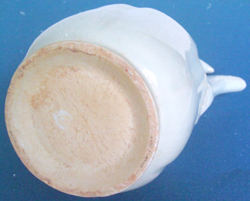|

The
Story of
Qingbai
Ceramics
Qingbai
Ceramics (known to the Chinese as Yingqing) were made at Jingdezhen and at many other southern kilns from the time of the Northern Song Dynasty.
The style dominated the imperial courts of China and the majority of
excavated tombs of upper-class people of the Sung period included
Qingbai Stoneware and Porcelain. It was not until the 14th century
that under-glaze decorated Blue and White Porcelain eclipsed Qingbai.
Qingbai in Chinese literally means "clear
bluish-white". The Qingbai glaze is a Porcelain glaze, so-called because it was made using
Porcelain stone. The
Qingbai glaze is clear, but contains iron in small amounts. When applied over a white
Porcelain body the glaze produces a greenish-blue colour that gives the glaze its name.
Toward the end of the Sung period, pieces began to be produced with incised or
molded decorations.
|
Qingbai Ewer
with Bird's Head
CERAMIC ARTIFACT #ww-000308
DESCRIPTION:
This Qingbai
(pronounced ching-pie) pouring vessel has a bird figure set to the top. It
has a bluish-green translucent glaze.
ORIGIN:
The
artifact was produced in China, probably in the region of Jingdezhen in
Jiangxi province. It was
brought to Southeast Asia as a valuable trade-good probably by an ancient Chinese trading
ship and sold among one of the many thriving Chinese communities
living in Southeast Asia. The object probably ended up as a burial
object
of a prominent individual. Centuries later, it was rediscovered by
excavators and subsequently acquired by The Chalre Collection through a registered dealer.
AGE:
Produced
in the Sung Dynasty period (960 - 1279).
MEASUREMENTS:
Height:
22cm (8.75in.)
Width or Depth: 11cm
(4.5in.)
REFERENCES:
Artifacts
with similar or identical shape and/or decorations are found in various publications
including: Song Dynasty
Ceramics, Chinese Ceramics,
Porcelains of the
Yuan Dynasty, Porcelains
of the Liao Song and Jin Dynasties, Porcelain
of the Song Dynasty Book I, Porcelain
of the Song Dynasty Book II, Guangdon Ceramics and Zhangzhou
Ware.
Similar
and/or identical
items are also on display at the Victoria & Albert Museum in London
(UK), the Asian Art Museum in San Francisco (USA), the National Museum
of Malaysia (Kuala Lumpur), the National Museum of the Philippines
(Manila) and
other museums
throughout the world with diverse collections of Asian ceramics.

|